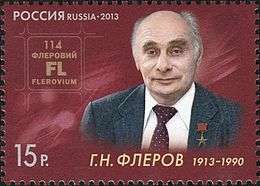Georgy Flyorov
| Georgy Flyorov | |
|---|---|
|
Georgy Flyorov on a 2013 Russian stamp | |
| Born |
Georgy Nikolayevich Flyorov 2 March 1913 Rostov-on-Don, Russian Empire |
| Died |
19 November 1990 (aged 77) Moscow, Russian Soviet Federative Socialist Republic, Soviet Union |
| Citizenship | Russia-Soviet Union |
| Nationality | Soviet |
| Fields | Thermal and Nuclear Physics |
| Institutions | Joint Institute for Nuclear Research |
| Alma mater | St. Petersburg State Polytechnic University |
| Known for | Discovery of spontaneous fission, Soviet atomic bomb project |
Georgy Nikolayevich Flyorov (Russian: Гео́ргий Никола́евич Флёров; IPA: [gʲɪˈorgʲɪj nʲɪkɐˈlajɪvʲɪtɕ ˈflʲɵrəf]; 2 March 1913 – 19 November 1990) was a Soviet nuclear physicist who was known for the discovery of spontaneous fission. In 2012, element 114 flerovium was named after the research laboratory at the Joint Institute for Nuclear Research bearing his name .[1]
Biography
Flyorov was born in Rostov-on-Don and attended the Leningrad Polytechnic Institute (now known as the St. Petersburg State Polytechnic University) and majored in thermal physics and nuclear physics.
He is known for writing to Stalin in April 1942, while serving as an air force lieutenant, and pointing out the conspicuous silence within the field of nuclear fission in the United States, Great Britain, and Germany.[2] Flyorov's urgings to "build the uranium bomb without delay"[3] eventually led to the development of the Soviet atomic bomb project.
He discovered spontaneous fission in 1940 with Konstantin Petrzhak. He also claimed as his discovery two transition metal elements: seaborgium[4] and bohrium.[5]
He founded the Flyorov Laboratory of Nuclear Reactions (FLNR), one of the main labs of the Joint Institute for Nuclear Research in Dubna in 1957, and was director there until 1989. Also during this period, he chaired the Scientific Council of the USSR Academy of Sciences.
Honours and awards
- Hero of Socialist Labour (1949)
- Two Orders of Lenin (1949, 1983)
- Order of the October Revolution (1973)
- Order of the Red Banner of Labour, three times (1959, 1963, 1975)
- Order of the Patriotic War, 1st class (1985)
- Lenin Prize (1967)
- Stalin Prize, twice (1946, 1949)
- USSR State Prize (1975)
- Honorary Citizen of Dubna
- The element Flerovium (atomic number 114) named after him
References
- ↑ Brown, Mark (6 June 2011). "Two Ultraheavy Elements Added to Periodic Table". Wired. Retrieved 6 June 2011.
- ↑ Kean, Sam (12 July 2010). The Disappearing Spoon: And Other True Tales of Madness, Love, and the History of the World from the Periodic Table of the Elements. Little, Brown. pp. 86–. ISBN 978-0-316-08908-1.
- ↑ Cochran TB et al. (1995) Making the Russian bomb from Stalin to Yeltsin. Natural Resources Defense Council
- ↑ Oganesyan Yu.Ts.; Tret'yakov Yu.P.; M'inov A.S.; Demin A.G.; A.A. Pleve A.A.; Tret'yakova S.P.; Plotko V.M.; Ivanov M.P.; Danilov N.A.; Korotkin Yu.S.; Flerov G.N. (1974). "Synthesis of neutron-deficient isotopes of fermium, kurchatovium, and element 106". JETP Letters. 20 (8): 265. Bibcode:1974JETPL..20..265O. Original Russian version.
- ↑ Oganesyan Yu.Ts.; Demin A.G.; Danilov N.A.; Ivanov M.P.; Il'inov A.S.; Kolesnikov N.N.; Markov B.M.; Plotko V.M.; Tret'yakova S.P.; Flerov G.N. (1976). "Synthesis of neutron-deficient isotopes of fermium, kurchatovium, and element 106". JETP Letters. 23 (5): 277. Bibcode:1976JETPL..23..277O. Original Russian version.
External links
| Wikimedia Commons has media related to Georgy Flyorov. |
- Significant Flerov Dates
- Annotated bibliography of Georgy Flerov from the Alsos Digital Library
- A draft of Flerov's letter to Stalin
